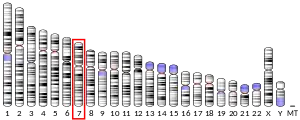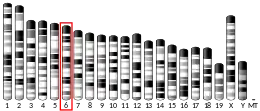DFNA5
Non-syndromic hearing impairment protein 5 is a protein that in humans is encoded by the DFNA5 gene.[5][6][7]
Function
Hearing impairment is a heterogeneous condition with over 40 loci described. The protein encoded by this gene is expressed in fetal cochlea, however, its function is not known. Nonsyndromic hearing impairment is associated with a mutation in this gene.[7]
The observation that DFNA5 is epigenetically inactivated in a large number of cancers of frequent types (gastric, colorectal, and breast) is another important finding and is in line with its apoptosis-inducing properties. Indeed, if apoptosis is an intrinsic feature of DFNA5, shutting the gene down in tumor cells makes them more susceptible to uncontrolled cellular growth. Moreover, the fact that DFNA5 is regulated by P53 strongly suggests that DFNA5 is a tumor suppressor gene.[8]
References
- GRCh38: Ensembl release 89: ENSG00000105928 - Ensembl, May 2017
- GRCm38: Ensembl release 89: ENSMUSG00000029821 - Ensembl, May 2017
- "Human PubMed Reference:". National Center for Biotechnology Information, U.S. National Library of Medicine.
- "Mouse PubMed Reference:". National Center for Biotechnology Information, U.S. National Library of Medicine.
- van Camp G, Coucke P, Balemans W, van Velzen D, van de Bilt C, van Laer L, Smith RJ, Fukushima K, Padberg GW, Frants RR (Mar 1996). "Localization of a gene for non-syndromic hearing loss (DFNA5) to chromosome 7p15". Hum Mol Genet. 4 (11): 2159–63. doi:10.1093/hmg/4.11.2159. hdl:2066/20568. PMID 8589696.
- Van Laer L, Van Camp G, van Zuijlen D, Green ED, Verstreken M, Schatteman I, Van de Heyning P, Balemans W, Coucke P, Greinwald JH, Smith RJ, Huizing E, Willems P (Mar 1998). "Refined mapping of a gene for autosomal dominant progressive sensorineural hearing loss (DFNA5) to a 2-cM region, and exclusion of a candidate gene that is expressed in the cochlea". Eur J Hum Genet. 5 (6): 397–405. doi:10.1159/000484798. PMID 9450185.
- "Entrez Gene: DFNA5 deafness, autosomal dominant 5".
- de Beeck KO, Van Laer L, Van Camp G (Mar 2012). "DFNA5, a gene involved in hearing loss and cancer: a review". The Annals of Otology, Rhinology, and Laryngology. 121 (3): 197–207. doi:10.1177/000348941212100310. PMID 22530481. S2CID 32637216.
Further reading
- Andersson B, Wentland MA, Ricafrente JY, Liu W, Gibbs RA (1996). "A "double adaptor" method for improved shotgun library construction". Anal. Biochem. 236 (1): 107–13. doi:10.1006/abio.1996.0138. PMID 8619474.
- Yu W, Andersson B, Worley KC, Muzny DM, Ding Y, Liu W, Ricafrente JY, Wentland MA, Lennon G, Gibbs RA (1997). "Large-scale concatenation cDNA sequencing". Genome Res. 7 (4): 353–8. doi:10.1101/gr.7.4.353. PMC 139146. PMID 9110174.
- Thompson DA, Weigel RJ (1998). "Characterization of a gene that is inversely correlated with estrogen receptor expression (ICERE-1) in breast carcinomas". Eur. J. Biochem. 252 (1): 169–77. doi:10.1046/j.1432-1327.1998.2520169.x. PMID 9523727.
- Van Laer L, Huizing EH, Verstreken M, van Zuijlen D, Wauters JG, Bossuyt PJ, Van de Heyning P, McGuirt WT, Smith RJ, Willems PJ, Legan PK, Richardson GP, Van Camp G (1998). "Nonsyndromic hearing impairment is associated with a mutation in DFNA5". Nat. Genet. 20 (2): 194–7. doi:10.1038/2503. PMID 9771715. S2CID 23534085.
- Grottke C, Mantwill K, Dietel M, Schadendorf D, Lage H (2000). "Identification of differentially expressed genes in human melanoma cells with acquired resistance to various antineoplastic drugs". Int. J. Cancer. 88 (4): 535–46. doi:10.1002/1097-0215(20001115)88:4<535::AID-IJC4>3.0.CO;2-V. PMID 11058868.
- Van Laer L, DeStefano AL, Myers RH, Flothmann K, Thys S, Fransen E, Gates GA, Van Camp G, Baldwin CT (2003). "Is DFNA5 a susceptibility gene for age-related hearing impairment?". Eur. J. Hum. Genet. 10 (12): 883–6. doi:10.1038/sj.ejhg.5200878. PMID 12461698.
- Gregan J, Van Laer L, Lieto LD, Van Camp G, Kearsey SE (2003). "A yeast model for the study of human DFNA5, a gene mutated in nonsyndromic hearing impairment". Biochim. Biophys. Acta. 1638 (2): 179–86. doi:10.1016/s0925-4439(03)00083-8. PMID 12853124.
- Yu C, Meng X, Zhang S, Zhao G, Hu L, Kong X (2004). "A 3-nucleotide deletion in the polypyrimidine tract of intron 7 of the DFNA5 gene causes nonsyndromic hearing impairment in a Chinese family". Genomics. 82 (5): 575–9. doi:10.1016/S0888-7543(03)00175-7. PMID 14559215.
- Bischoff AM, Luijendijk MW, Huygen PL, van Duijnhoven G, De Leenheer EM, Oudesluijs GG, Van Laer L, Cremers FP, Cremers CW, Kremer H (2004). "A novel mutation identified in the DFNA5 gene in a Dutch family: a clinical and genetic evaluation". Audiol. Neurootol. 9 (1): 34–46. doi:10.1159/000074185. PMID 14676472. S2CID 20139112.
- Masuda Y, Futamura M, Kamino H, Nakamura Y, Kitamura N, Ohnishi S, Miyamoto Y, Ichikawa H, Ohta T, Ohki M, Kiyono T, Egami H, Baba H, Arakawa H (2006). "The potential role of DFNA5, a hearing impairment gene, in p53-mediated cellular response to DNA damage". J. Hum. Genet. 51 (8): 652–64. doi:10.1007/s10038-006-0004-6. PMID 16897187.
- Van Laer L, Meyer NC, Malekpour M, Riazalhosseini Y, Moghannibashi M, Kahrizi K, Vandevelde A, Alasti F, Najmabadi H, Van Camp G, Smith RJ (2007). "A novel DFNA5 mutation does not cause hearing loss in an Iranian family". J. Hum. Genet. 52 (6): 549–52. doi:10.1007/s10038-007-0137-2. PMID 17427029. S2CID 24786210.





